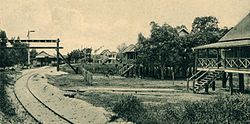Demerara-Berbice railway

The Demerara-Berbice Railway, built in then British Guiana (now Guyana), was the first railway system in South America. [1] It ran from Georgetown in Demerara to Rosignol in Berbice. [2]
History
The bill proposing the construction of the railway was passed in July 1846. [1] The railway was designed, surveyed and built by the British-American architect and artist Frederick Catherwood. All the railway stations, bridges, stores and other facilities were constructed by John Bradshaw Sharples. [3] Financing was provided by the Demerera Sugar Company who wished to transport their product to the dock of Georgetown. Construction was in sections with the first, from Georgetown to Plaisance, opening on 3 November 1848. The opening day's festivities featured the death of one of the railway's directors by being run over by the locomotive.
An extension to Belfield was completed in 1854, to Mahaica in 1864 and finally to Rosignol during 1897–1900.
In 1948 the railway system in Bermuda was dismantled and sold 'lock, stock & barrel' to the government of British Guiana (as the country then was) to rejuvenate the former system. The locomotives (petrol or diesel [just 2]) and coaches were fully restored, the latter being painted dark green. In 1953 the public lines in the colony carried 1,772,954 passengers and 92,769 tonnes of freight. A bold plan to extend the railway south to Brazil was never proceeded with.
The public railway system was dismantled in stages by then President Forbes Burnham, and closed in 1972. [4]
Service
Following the opening in 1848, there were two return trains per day between Georgetown and Plaisance. [5]
In 1922 there was one train each week day, departing Georgetown at 08:00 and returning in the evening. [2]
The Georgetown-Rosignol railway service ended in 1972.
Infrastructure
There were three major bridges on the line, all constructed of steel, across the Mahaica, Mahaicony and Abary Rivers. [5]
There were 17 stations on the Demerara-Berbice Railway: [6]
- Georgetown
- Bel Air
- Plaisance
- Beterverwagting
- Buxton
- Nonpareil
- Enmore
- Golden Grove
- Belfield
- Clonbrook
- Mahaica
- de Kinderen
- Mahaicony
- Belladrum
- Lichfield
- Fort Wellington
- Rosignol
Rolling stock
In 1936, the Colonial Transport Department owned 16 locomotives, 39 coaches and 283 goods wagons. [7]
Locomotives
| Acquired | Disposed | Name | Number | Cost | Use | Notes |
|---|---|---|---|---|---|---|
| 1847 | Mosquito | [5] | ||||
| 1847 | Sandfly | [5] | ||||
| 1847 | Firefly | [5] | ||||
| 1863 | Alexandra | £1,593 | Relief engine | [8] | ||
| 1863 | 1921 | Victoria | £1,593 | [8] | ||
| 1924 | Sir Wilfred | 30 | [9] | |||
| 1924 | Sir Graeme | 31 | [9] [10] | |||
| 1946 | Sir Gordon | 34 | [9] | |||
| 1946 | Sir John | 35 | [9] |

